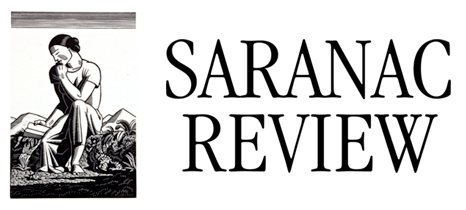Issue 19 Editor’s Note
Our Interior Machinery
Sara Schaff
The artist’s job is, primarily, to attend to their own inner workings—their obsessions, loves, hopes, fears, anxieties, and dreams. Ideally, that artistic pursuit will resonate with people who encounter the art—the outcome of the pursuit. But it’s the pursuit itself that, for me, is at the core of the work we do as artists, as teachers, and as a literary magazine.
Last fall, we made a special issue of Saranac Review about making art in times of crisis. The issue felt necessary and urgent to me and Prose Editor Gbolahan Adeola, and though we’ve moved on in our editorial capacity to Issue 19, the crises of the worlds have only intensified. The work of this issue feels of the moment, in response to the world we live in now, and still utterly in alliance with the objective laid out above: we must attend to our inner workings. Or else.
But in the powerful words of Issue 19 contributor Evan Massey, “Not many of us, I think, study our internal machines.” His essay, “The Machine,” reveals the consequences of both ignoring and following the assignment; in “caging” our interiority, we remove ourselves from the world and from our selves. How much easier it is to dehumanize and destroy when we’re cut off from our own deepest humanity.
What would the world look like if more of us did the artist’s work of reflection, of daydreaming, and of connection? In her brilliant series of comics, Belle (Bom) Kim makes visual and tangible this very process, and in doing so, reveals a beautiful, empathetic humor and joy for life. In her play, “You Have the Whole World Hostage,” Abigail Mandlin uses grim absurdity to convey how a lack of imagination, self-reflection, and empathy has contributed to a political and media apathy toward the horror of mass shootings. And in L. Vocem’s haunting short story, “The Pleasure Model,” a woman regains a connection with her own inner self by connecting with a more-human-than-human robot.
Again and again, the contributors of Issue 19 show us what happens when we actually do the work: when we study, when we care, when we ask questions instead of starting off every conversation with answers we’ve already decided on. They’re doing the work even though it is minimized and threatened every day, especially in the places one might hope it’s most readily supported—college campuses. At nearby Vermont State University this fall, for example, administrators eliminated the Performing Arts and Technology program. And this academic year, many of my colleagues in the arts over at SUNY Potsdam have lost their jobs; the administration eliminated the vital performing arts program, and due to faculty cuts in creative writing, the English Department there will be forced to deactivate its BFA in creative writing, the only degree of its kind at an upstate SUNY.
At colleges across the country, the message is similar: in times of economic difficulty, cut the arts. But in firing arts faculty and eliminating entire artistic programs, we’re also cutting off our students (and the communities in which we live and work) from a vital source of creativity and community. The arts are not a solution to all the world’s ills, but they are a tool and a resource we need to harness and protect.
I love what we do at Saranac Review and in the Editing and Publishing seminar at SUNY Plattsburgh, the course that helps to create each online issue of the magazine. I’m lucky I still get to do it! And I’m lucky to have worked with such a generous and talented group of students this semester. Putting together Issue 19 was an especially collaborative and creative process, a real community effort. And we couldn’t have done it without our guest readers or without the tremendous insights of Drama Editor Shawna Mefferd Kelty and Prose Editor Gbolahan Adeola. Nothing is possible without Lauren Waldron, our Operations Assistant at SR, and the SUNY Plattsburgh English Department’s Administrative Assistant.
Finally, and especially, love and gratitude to our talented contributors of Issue 19. Each arresting work of art here honors Massey’s idea of that precious “interior machinery”—the self that we must love and honor—in order to be free.

